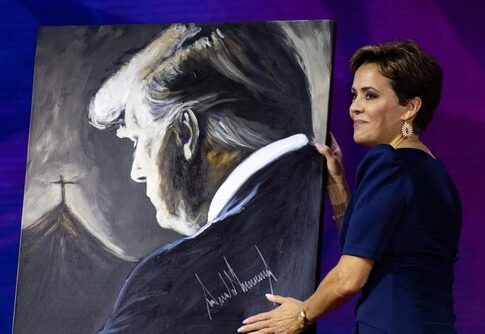The contentious portrait of President Donald Trump in the Colorado Capitol is set to be removed following Republican leaders’ requests, sparking a nationwide debate over artistic expression in political spaces. The oil painting has drawn sharp criticism from Trump himself, who claimed on Truth Social that the artwork was “purposefully distorted” compared to the flattering portrait of Obama. How might the standard for presidential portraiture change after this precedent?
Trump’s Criticism Leads to Portrait Removal
President Donald Trump’s portrait at the Colorado State Capitol will be removed after he publicly criticized the artwork as being “purposefully distorted.” The oil painting, which was unveiled in 2019 and created by artist Sarah Boardman during Trump’s first term, has become the center of a heated debate about artistic representation in political spaces.
Trump took to his Truth Social platform to express his dissatisfaction, saying, “Nobody likes a bad picture or painting of themselves, but the one in Colorado, in the State Capitol put up by the Governor, along with all other Presidents, was purposefully distorted to a level that even I, perhaps, have never seen before.” The president specifically compared the work unfavorably to Boardman’s portrait of President Obama, claiming, “The artist also did President Obama, and he looks wonderful, but the one of me is truly the worst.”
I agree with President Trump.. Someone throw this garbage portrait in the trash.. It doesn't even look like him. pic.twitter.com/SzSOkEjHGc
— aka (@akafaceUS) March 24, 2025
Funding and Context of the Controversial Artwork
The portrait was funded through a GoFundMe campaign that raised over $10,000 from state Republicans to ensure Trump was represented alongside other presidents in the Capitol building. This crowdfunding effort demonstrated strong support from Republican constituents who wanted Trump’s image displayed in the presidential gallery, making the current controversy particularly significant for those who contributed to the portrait’s creation.
Artist Sarah Boardman has maintained that official portraits are meant to be accepted or rejected by viewers, suggesting the subjective nature of artistic interpretation. Trump, however, claimed to be acting on behalf of Colorado residents, stating, “In any event, I would much prefer not having a picture than having this one, but many people from Colorado have called and written to complain. In fact, they are actually angry about it!”
Donald Trump is not happy about this portrait and to be fair, it looks nothing like him. pic.twitter.com/3xHem19Alb
— Alexandra Marshall (@ellymelly) March 24, 2025
Broader Implications for Political Artwork
The decision to remove the portrait raises important questions about the role of art in political spaces and who ultimately controls representations of public figures. Republican leaders in Colorado responded swiftly to Trump’s complaints, highlighting the significant influence political figures can wield over their official portrayals even years after the artwork has been displayed.
Trump directly called on Colorado Governor Jared Polis to remove the painting, demonstrating the political pressure that can be applied in such situations. The incident illustrates the ongoing tension between artistic expression and political sensitivity, particularly in government buildings where images of leaders are expected to convey a certain level of dignity and respect regardless of partisan affiliations.

